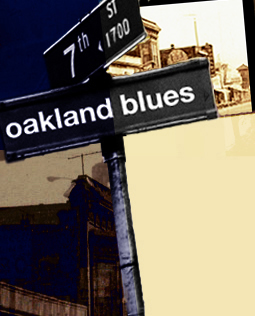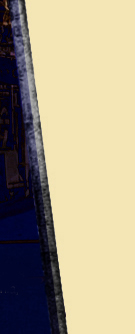Behind the Scenes
- A Note on the Accuracy of the Game
- More on Virtual Reality & Storytelling
- Project Team
- Special Thanks
This video game grew out of the collaboration of people who don’t often find themselves working together – journalists and architects. We wanted to create a virtual neighborhood that looked and sounded like the one that existed in West Oakland after the Second World War. We wanted people who remembered that world to feel like they’d gone back in time – and for players of all ages to enjoy exploring and learning about the music and history of 7th Street.
It started with two faculty members at UC Berkeley coming together across disciplines to explore a shared interest in recreating the past. Paul Grabowicz, who directs the New Media Program at the Graduate School of Journalism, had became fascinated with the lost music scene on 7th Street after he wrote about it as a reporter for The Oakland Tribune in the early 1980s. At the Department of Architecture, Prof. Yehuda Kalay had been using virtual reality programs to recreate lost civilizations, from medieval Cairo to an ancient archeological site in Turkey, so scholars and students could understand not just the built environment, but also the cultural and social context on which it was founded.
The two met through the Berkeley Center for New Media, a campus initiative launched in 2003 to bring together faculty from different disciplines who might discover a common interest in research projects in digital technologies. They launched the 7th Street video game project in 2006, using video game technology. The Architecture Department had recreated the blues and jazz clubs scene that Grabowicz had written about. A graduate research group was formed at the Department of Architecture to begin researching 7th Street and model and program the virtual world. In Spring 2007, a Journalism School class was created to dig into the past of 7th Street and begin developing a video game narrative to tell its story.
A series of community meetings, co-sponsored by The Oakland Post, the city’s African-American newspaper, was held so students could hear first-hand the stories of people who remembered 7th Street. From these meetings, and dozens of interviews that journalism students conducted over the next few years, the 7th Street world took shape, based on the people who lived, worked and made music there. The many people who shared their memories and photographs with us were vital to our effort to revive the music and history of West Oakland.
Journalism students also scoured the archives of local newspapers, museums and libraries to help reconstruct what 7th Street was like before it was wiped out by a series of ill-fated development projects in the late 1950s and 1960s. The Cypress Freeway was constructed, cutting the area off from the downtown. An elevated Bay Area Rapid Transit (BART) rail line was built down the middle of the street. And 12 square blocks of homes and businesses were demolished to make way for an immense postal distribution facility. By the 1970s, all of the famed blues and jazz clubs of the era save one – Esther’s Orbit Room – had closed. Many of the buildings that lined 7th Street were boarded up or torn down.
Armed with photographs of 7th Street from the 1940s and 1950s that journalism students dug up, the architecture students began creating models of the old buildings to populate a video game world, using the Torque video game engine. Journalism students also pieced together the stories of the people of 7th Street that Architecture students then used to create avatars based on real-life characters from the era.
To try to ensure the authenticity of the virtual world we were creating, in Fall 2007 we showed a video of our game world at the West Oakland Senior Center to people who remembered the real 7th Street. We were thrilled when they connected the virtual world with their own memories. One 90-year-old man put his finger on the computer screen, pointed at a seat in a virtual bar, and told us “This is where Joe Lewis used to sit,” referring to the former world heavyweight champion boxer.
Finding photographs – especially of the lively crowded street that people told us about – posed one of the biggest challenges. We made valuable discoveries in the collections at local museums and libraries. We also were given personal photos by people who lived in the area at the time. But we know many more photos are out there in the West Oakland community…in picture books, in attics, or in boxes under beds. We continue to seek more photos and memories from people in West Oakland to incorporate into our virtual world and game.
Reconstructing the buildings that were demolished posed another challenge. The photographs we found showed mostly people, not buildings. Detective-like sleuthing was needed to piece together a coherent building out of a handful of photos showing the same set of rooms. Using their architectural skills, the students were able to reconstruct some of the lost floor plans, which were needed to allow movement in the virtual world between the different rooms in a building.
As the musicians and patrons of the club scene from the 1940s and ’50s have started to pass away, preserving their story for a new generation has also become critically important. But how to engage young people in the story of 7th Street was another challenge. Just creating a virtual world to explore would not engross young people used to playing sophisticated video games. So journalism students also developed a video game narrative that people could play to learn about 7th Street. We put the player in the role of a musician who must complete a series of quests to get his or her music recorded, distributed, financed and performed on 7th Street. Architecture students then programmed the Torque game engine with the game play sequences, and devised a way for the player to don authentic clothing from the era. A music student added a way for players to jam with a virtual band at one of the music clubs at the start of the game. We also talked with many people who work on video games for guidance. Video game consultant Jeannie Novak came to talk to architecture students about the game design, and video game writer Lee Sheldon visited the journalism class to work with students on developing the narratives.
Still, we wondered if teenagers, used to playing action-packed and often violent video games, would be drawn to a historically-based narrative like the one we were creating for our game. A key test came in Spring 2008, when we brought in a group of teenagers to test the game. We were relieved that even the most sophisticated players among them were drawn into the virtual world and game play we had created. Some of them said they would be particularly interested in playing the game simultaneously with older people who actually remembered what the real 7th Street was like. In the future, we’ll be working on more iterations of the game. We will integrate the stories and photos that people continue to send us into additional quests. And we will be working on bringing together old and young in a new kind of joint game play that spans generations.
“Remembering 7th Street” is a labor of love, created by architects, journalists and, most of all, the people of West Oakland. We hope that players enjoy taking a trip back in time as much as we did.



